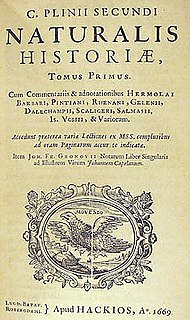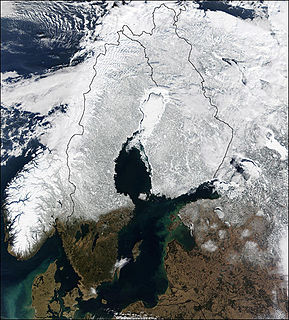Related Research Articles
Pliny may refer to:

The Natural History is a work by Pliny the Elder. It is one of the largest single works to have survived from the Roman Empire to the modern day and purports to cover all ancient knowledge. The work's subject area is thus not limited to what is today understood by natural history; Pliny himself defines his scope as "the natural world, or life". It is encyclopedic in scope, but its structure is not like that of a modern encyclopedia. It is the only work by Pliny to have survived, and the last that he published. He published the first 10 books in AD 77, but had not made a final revision of the remainder at the time of his death during the AD 79 eruption of Vesuvius. The rest was published posthumously by Pliny's nephew, Pliny the Younger.

The Getae or Gets were several Thracian tribes that once inhabited the regions to either side of the Lower Danube, in what is today northern Bulgaria and southern Romania. Both the singular form Get and plural Getae may be derived from a Greek exonym: the area was the hinterland of Greek colonies on the Black Sea coast, bringing the Getae into contact with the ancient Greeks from an early date. Although it is believed that the Getae were related to their westward neighbours, the Dacians, several scholars, especially in the Romanian historiography, posit that the Getae and the Dacians were the same people.

The Turduli Veteres, translated as "Ancient Turduli" or "Old Turduli" were an ancient pre-Roman tribe of present day Portugal, akin to the Calaicians or Gallaeci and Lusitanians.

The Cantabri or Ancient Cantabrians, were a pre-Roman people, probably Celtic or pre-Celtic European, and large tribal federation that lived in the northern coastal region of ancient Iberia in the second half of the first millennium BC. These peoples and their territories were incorporated into the Roman Province of Hispania Tarraconensis in the year 19 BC, following the Cantabrian Wars.

The Hilleviones were a Germanic people occupying an island called Scatinavia in the 1st century AD, according to the Roman geographer Pliny the Elder in Naturalis Historia, written circa 77 AD. Pliny's Scatinavia is generally believed to have referred to the Scandinavian peninsula, which in the 1st century AD had not yet been fully explored by the Romans and was therefore described as an island. Pliny wrote that it was an island "of a magnitude as yet unascertained". The Hilleviones lived in the only part of the island that was known, and according to Pliny, they thought of their 500 villages as a separate (alterum) world.

The Varduli were a pre-Roman tribe settled in the north of the Iberian Peninsula, in what today is the eastern region of the autonomous community of the Basque Country and western Navarre, in northern Spain. Their historical territory corresponds with current Basque-speaking areas, however it is debated whether the Varduli were actually Aquitanians, related to the Vascones, or if they were Celts, related to tribes such as the Cantabri and Celtiberians and which later underwent Basquisation.
Agamede was a name attributed to two separate women in classical Greek mythology and legendary history.

The Taurisci were a federation of Celtic tribes who dwelt in today's Carinthia and northern Slovenia (Carniola) before the coming of the Romans According to Pliny the Elder, they are the same people known as the Norici.

Ariana, the Latinized form of the Ancient Greek Ἀρ(ε)ιανή Ar(e)ianē, originating from the Old Persian word Ariyanem (Ariana) meaning "The Land of the Aryans", similar to the use of Āryāvarta. It was a general geographical term used by some Greek and Roman authors of the ancient period for a district of wide extent between Central Asia and the Indus River, comprising the eastern provinces of the Achaemenid Empire that covered the whole of modern-day Afghanistan, as well as the easternmost part of Iran and up to the Indus River in Pakistan.

The Turmodigi were a pre-Roman ancient people, later mixed with the Celts people of northern Spain who occupied the area within the Arlanzón and Arlanza river valleys in the 2nd Iron Age.
Pactya or Paktye was an ancient Greek city located in ancient Thrace, on the Thracian Chersonesus. It is cited in the Periplus of Pseudo-Scylax, in its recitation of the towns of the Thracian Chersonesus, along with Aegospotami, Cressa, Crithote and then Pactya, situated 36 stadia from Cardia. It is said that Miltiades founded it. Strabo places it on the Propontis between Crithote and Macron Teichos. According to Herodotus, Miltiades the Elder ordered a wall built between Cardia, which was on the coast of Gulf of Melas and Pactya, which was on the Propontis side, to prevent invasion of the Chersonesus by the Apsinthii. Alcibiades retired here the Athenians had for the second time deprived him of the command. It was a member of the Delian League. Pliny the Elder points out that both Cardia and Pactya later joined to form Lysimachia.

The Pellendones were an ancient pre-Roman Celtic people living on the Iberian Peninsula. From the early 4th century BC they inhabited the region near the source of the river Duero in what today is north-central Spain. The area comprises the north of Soria, the southeast of Burgos and the southwest of La Rioja provinces.

The Allotriges or ‘Allotrigones’, were a small ‘Celticized’ mountain people mentioned alongside the Plentauri by Ptolemy and Strabo, as inhabitants of the region roughly corresponding to present-day northwestern La Rioja, around the area of the Ebro sources.
The Marsaci or Marsacii were a tribe in Roman imperial times, who lived within the area of the Rhine–Meuse–Scheldt delta, under Roman domination.
Coryphas or Koryphas, also known as Coryphantis or Koryphantis (Κορυφαντίς), was one of the settlements of the Mytilenaeans, on the coast of ancient Aeolis, opposite to Lesbos, and north of Atarneus. It is evidently the same place which appears in the Tabula Peutingeriana under the name Corifanio, between Adramyttium and Elateia — which may be another name of Heraclea. Strabo mentions Coryphantis and Heraclea, and "after them, Attea." The oysters of Coryphas are mentioned by Pliny the Elder.
Pordoselene or Poroselene (Ποροσελήνη) was a town and polis (city-state) of ancient Aeolis. It was located on the chief island of the Hecatonnesi, a group of small islands lying between Lesbos and the coast of Asia Minor, which was also called Prodoselene. Strabo says that some, in order to avoid the dirty allusion presented by this name, called it Poroselene, which is the form employed by Ptolemy, Pliny the Elder, and Aelian. At a still later time the name was changed into Proselene, under which form the town appears as a bishop's see. Aristotle mentions the town in his History of Animals where it was on the extremity of a road that formed the border between an area of the island that contained weasels and another area that did not have them.
Homana or Homona, also known as Homonadeis, was a town of ancient Pisidia and later of Isauria and Lycaonia, inhabited in Hellenistic and Roman times. Pliny the Elder puts the town in Pisidia. It appears in the Synecdemus as part of Lycaonia under the name Umanada or Oumanada. It was the capital of the Homanades (Ὁμαναδεῖς), who, besides Homana, are said by Tacitus to have possessed 44 forts, a statement opposed to the remarks of Strabo, according to which the Homanades, the most barbarous of all Pisidian tribes, dwelt on the northern slope of the highest mountains without any towns or villages, living only in caves. In the reign of Augustus, the consul Quirinius compelled this little tribe, by famine, to surrender, and distributed 4000 of them as colonists among the neighbouring towns. It became a bishopric; no longer the seat of a residential bishop, it remains, under the name of Homona, a titular see of the Roman Catholic Church.

Gaius Furius Chresimus, or Cresimus, or Cressinus, was a 2nd-century BC Greek farmer and freedman in the Roman Republic mentioned in a fragment of the lost history of Lucius Calpurnius Piso Frugi, preserved in Pliny's Natural History. Piso tells that Furius Chresimus was acquitted of accusations of witchcraft during the aedileship of Spurius Postumius Albinus, dated 191 BC. The trial took place in a period of reaction against the growing influence of Hellenism at Rome, notably led by Albinus. Both Piso and Pliny told the story of the trial for its moralizing aspect.
References
- ↑ Wilkes, J. J. The Illyrians, 1992, ISBN 0-631-19807-5, page 95
- ↑ The Cambridge Ancient History by Alan K. Bowman, ISBN 0521264308, page 575
- ↑ Naturalis Historia.
- ↑ "PLINII NATVRALIS HISTORIAE LIBER III" . Retrieved 2008-07-16.
- ↑ "Pliny the Elder, The Natural History, BOOK III. AN ACCOUNT OF COUNTRIES, NATIONS, SEAS, TOWNS, HAVENS, MOUNTAINS, RIVERS, DISTANCES, AND PEOPLES WHO NOW EXIST OR FORMERLY EXISTED., CHAP. 25. (21.)—LIBURNIA AND ILLYRICUM" . Retrieved 2017-11-09.